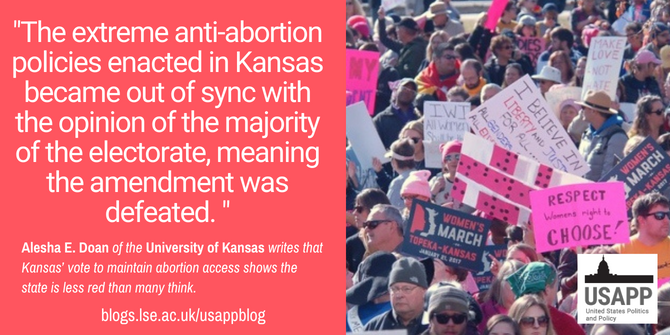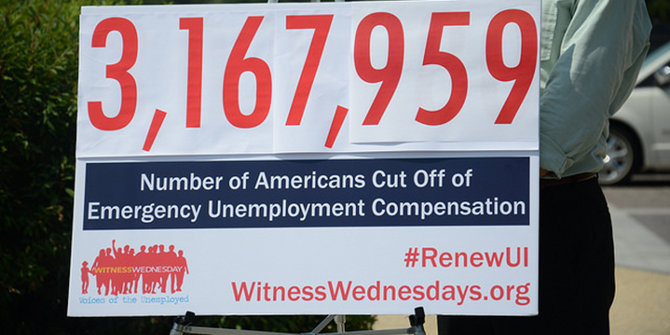 Following the US Supreme Court’s Dobbs v. Jackson Women’s Health Organization decision, Kansans have voted against a ballot measure that would have removed abortion rights from the state’s constitution. Alesha E Doan argues that this vote is not as shocking as some pundits and news outlets have suggested, as there is a mismatch between the state’s more progressive electorate and its deeply conservative elected government, which has been influenced heavily by anti-abortion lobbyists over the last three decades.
Following the US Supreme Court’s Dobbs v. Jackson Women’s Health Organization decision, Kansans have voted against a ballot measure that would have removed abortion rights from the state’s constitution. Alesha E Doan argues that this vote is not as shocking as some pundits and news outlets have suggested, as there is a mismatch between the state’s more progressive electorate and its deeply conservative elected government, which has been influenced heavily by anti-abortion lobbyists over the last three decades.
Demystifying the Kansans Abortion Vote
Kansas voters were the first to take to the ballot in the wake of the June 2022 US Supreme Court’s Dobbs v. Jackson Women’s Health Organization decision, which eliminated federal protection for abortion rights and empowered individual states to determine the legality of abortion. Shocking the nation on August 2, the Kansan electorate decisively defeated an amendment (59 percent to 41 percent) to remove abortion rights from the state’s constitution in the state’s primary election. The abortion rights victory in Kansas flooded national and international news outlets, with political pundits calling the vote a “landslide,” a “political earthquake,” a “lopsided loss,” and President Biden praising the defeat of the amendment.
The vote in Kansas provided abortion rights supporters around the nation a desperately needed victory and reason to sow hope. However, describing the abortion rights victory in Kansas as a shocking “political earthquake,” glosses over the strategic political maneuvering that has taken place in Kansas and other Midwestern states. Anti-abortion organizations, along with other conservative operatives, have methodically orchestrated the state’s decades-long march to the right. The state legislature’s ultra-conservative turn has resulted in a broad caricature of Kansas simplistically being depicted in the media as a deeply red state.
Moving beyond a political color coding, Kansas has an important story to tell about the potential for political change which stems from the state’s ambitious attempts to bypass the array of opinions that exist within its political parties and citizens. The extreme anti-abortion policies enacted in Kansas became out of sync with the opinion of the majority of the electorate, meaning the amendment was defeated. The growing divide between state politics and citizens’ support for abortion rights also has implications for other states that have followed a similar, and troubling, path.
The History of Abortion Rights in Kansas
For Kansans, the fight for abortion rights started long before political pundits were clamoring to explain the unexpected abortion rights victory this summer. Kansas has always been a pivotal state for accessing abortion care for thousands of people living in the Midwest. Years before the Dobbs decision, Kansas clinics were providing abortion care to out-of-state residents. In fact, nearly half (48.9 percent) of the abortions performed annually in Kansas are for out-of-state residents since Kansas had minimal restrictions on abortion care up until 2010. But the policy landscape rapidly started to change in 2011, following years of tactical planning by anti-abortion activists and kindred allies.
Anti-abortion activists have had a strong presence in Kansas dating back to the infamous 1991 “Summer of Mercy” tour when thousands of abortion foes traveled across the US to protest at clinics with the intent to close them. Kansas was specifically targeted for protest because it had minimal restrictions on abortion care. When the tour descended on Wichita, activists protested for 46 days outside of three clinics and shut them down for a week.

“Women’s March Topeka, KS 2017” (CC BY 2.0) by mmrogne
Anti-abortion activists were eager to change Kansas from a “middle ground” state to one that was hostile to abortion care. While most Kansans were preoccupied with the raucous protests in Wichita, abortion foes quietly began organizing a grass roots effort to reconfigure the state legislature beginning with recruiting uncompromising anti-abortion candidates for GOP precinct committee positions during Republican primary elections.
This strategy proved to be highly effective; by 1992 83 percent of the new Sedgwick County precinct committee members were ardently anti-abortion. Other populous areas of Kansas, like Johnson, Shawnee, and Douglas counties followed a similar trajectory.
The increasing reach of conservative interest groups in Kansas politics
Kansans for Life (KFL), an anti-abortion organization that supports lobbyists and operates a political action committee, was eager to join the effort to change Kansas from a middle ground state to a restrictive state. KFL focused on recruiting candidates to run for local and state elections and after several years, its efforts began to materialize in noticeable political changes. Moderate Republicans were being defeated by conservative, anti-abortion candidates in primary elections and by 1996, KFL backed candidates held a range of elected positions from US Senate and House seats, to state legislators, to district court judge and the state Board of Education.
Drawing on this successful strategy, KFL continued to work with other conservative interest groups to unseat moderate Republicans in primary elections. Voter turnout in Kansas primary elections is low, and Kansas is one of the few states that has a closed primary election, meaning that voters must declare their party affiliation before voting and they can only cast a ballot for candidates belonging to the same party. Thus, targeting primary elections, where turnout is low and voters are limited to voting for candidates in a particular party, means that a group can easily have an oversized impact on the outcome without expending a lot of money.
With each electoral victory, KFL’s political clout at the statehouse continued to grow throughout the 2000s. KFL solidified its reputation as the most powerful anti-abortion organization in the state when Governor Sam Brownback took office. KFL had unfettered access to the Governor and in the first year of his term, eight anti-abortion restrictions were passed, and an additional eleven more were passed by the end of Governor Brownback’s first term in 2014.
In the background of these strategic electoral victories largely etched out in primary elections, anti-abortion protestors had long become a permanent presence outside of Kansas abortion clinics. Dozens of crisis pregnancy centers also opened across the state, including one next door to Dr. George R. Tiller’s abortion clinic in Wichita, where he provided abortion care for more than 35 years until he was murdered by an anti-abortion activist in 2009.
The Divide Between Electorate and Elected
The electoral changes and visible anti-abortion presence in Kansas resulted in the passage of restrictive policies that ramped up state surveillance of women and abortion providers while fueling abortion stigma. Anti-abortion activists’ success with dramatically shifting policy and electoral politics to the ideological right, however, did not produce a similar shift in public opinion. Polling has found that over 60 percent of Kansans oppose abortion becoming completely illegal.
This imbalance between public opinion and anti-abortion policy made Kansas fertile ground for mobilizing an electorate that had largely been complicit in letting the state move to the far right. Ahead of the ballot measure vote, volunteers for Kansans for Constitutional Freedom, a non-partisan grass roots coalition, dedicated thousands of hours educating and mobilizing voters. A diverse constellation of citizens turned out to vote against the amendment in record numbers. In many counties that were thought to be anti-abortion strongholds, citizens voting against the amendment rivaled those voting for it.
Last month, Kansans delivered a decisive setback to the anti-abortion political agenda. However, anti-abortion advocates and legislators are already regrouping for the upcoming legislative session. Kansans can expect to see new policies introduced, enacted, and targeted at testing the limits of restrictions in this new context that is devoid of federal protection but shielded—for now—with state constitutional protections.
For other abortion rights supporters looking to learn from Kansas’s story, they can map a similar course if several conditions exist: a disconnect between policy and majority opinion, a willingness for local groups to engage in long-term collaborations to educate and mobilize voters, ongoing grass roots engagement in local elections, and a viable mechanism for placing an abortion rights measure on a ballot.
In states where these conditions exist, reproductive rights supporters will be fighting battles where conservative legislators are hastily introducing and enacting abortion bans before supporters can effectively mobilize opposition. Once these bans have passed into law, the pathway for countering these draconian policies becomes far more difficult.
We can expect to see these political battles unfold for the foreseeable future. As they develop, the legal chaos and public health crisis created by the US Supreme Court’s decision will continue to affect millions of people who no longer have agency and autonomy to chart the course of their reproductive lives.
Please read our comments policy before commenting.
Note: This article gives the views of the author, and not the position of USAPP – American Politics and Policy, nor the London School of Economics.
Shortened URL for this post: https://bit.ly/3B27NEV
About the author
 Alesha E. Doan – University of Kansas
Alesha E. Doan – University of Kansas
Alesha E. Doan is an Associate Dean in the College of Liberal Arts & Sciences at the University of Kansas. She is a Professor in the School of Public Affairs & Administration and the Women, Gender & Sexuality Studies Department. Professor Doan’s interdisciplinary research program is situated at the intersections between gender, public policy and organizations, with a substantive focus on reproductive politics, sexual violence, and gender & the military.






The recent outcome at the polls in Kansas should not surprise as Kansas voters have long been trending towards libertarian views. Social anthropologist Alexander Thomas T. Smith highlighted these changing cultural logics in his presentation at the Midwest Sociological Society conference held in 2009 at Saint Louis. A couple of articles on his Kansas research later was published leading journals. Nonetheless, Professor Doan’s contribution is a valuable confirmation.
Professor Smith and I have collaborated in the past and have shared research about Kansas politics since he first came to Kansas to conduct fieldwork. His insights and research are invaluable, and we have spent countless hours discussing Kansans politics. In the years following his field work, the composition of the state legislature in Kansas has become even more conservative and the libertarian views of Kansas voters have not been represented by elected officials. Presuming that elected representatives mirror the values and preferences of voters, from the perspective of the casual political pundit or observer, Kansas presents as an ultra-conservative state. However, to students of Kansas politics, like Professor Smith and me, the growing divide between the policy preferences of elected officials and the policy preferences of voters, is not surprising. The failed effort to pass the constitutional amendment is a tangible refection of this divide.